Arrival to El Calafate airport. Shuttle or bus from airport to El Chalten. Check in and free rest of day.



In Southern South America you will definitely need to stay connected via WhatsApp.
Travel with the affordable e-SIM. It allows you to use maps for navigation, communicate with tour and transfer services via WhatsApp, and keep in touch with friends and family.
Find a suitable data plan here: https://wyse.celitech.com/?REFID=WYSEMHIT100925
Free day to do some self guided treks, for example to Laguna de los Tres, where you reach the lagoon at the base of Mt Fitz Roy, after about 4 hours hike. It is recommended to begin between 7 and 8 am to be able to get to the lagoon and back.


Chalten visit
Just a visit to this town lets everyone understand why it has come to be called the Hiking Capital of Argentina. There is absolutely no doubt about that. Saying "Chaltén" in Patagonia is a synonym for mountain, walking, hiking, climbing, outdoors and the list could go on.
The town was created in 1985 as a geopolitical strategy that put an end to the border conflicts with Chile over Lago del Desierto. Ever since its modest origins, this small mountain district has developed according to the typical features of its first denizens: love for the mountain being the first one. Thus, the youngest town in Argentina continued to grow and today, with almost a thousand dwellers that reside there year round, it has a spirit of its own which makes it different from all the other Patagonian towns. For instance, there is no cell phone service by choice of most of its inhabitants.
A dreamed-of place for mountaineers and climbers from all over the world, El Chaltén has been declared the Hiking Capital of Argentina. Beyond this title, there are more than enough reasons for its visitors to set out along its hiking trails. There are plenty of attractions, reached through paths of various difficulties. All of them lead to ideal scenes that seem to become magical sites.
From the air, the town may be seen resting on the mountains by Lake Viedma, whereas one of its natural borders is the well-known Río de las Vueltas (River of the Bends), whose winding light-blue course when the waters run clear grants a supernatural facet to its shores.
El Chaltén is surrounded by ravines that announce the presence of the mountain range and is watched by the Viedma Glacier and the ancient massifs known as Mount Torre and Mount Fitz Roy.
Morning
Self Guided Treks
Free day to do more self guided treks, for example to Laguna Torre, where you can see the reflection of legendary Cerro Torre at the lagoon of the same name. It is a bit shorter than Laguna de los Tres but it is also recommended to depart early



El Chalten Hiking Trails
This are are six outstanding El Chaltén hiking routes to choose from:
1. LOS CÓNDORES AND LAS ÁGUILAS VIEWPOINTS: Distance: 6km (3.5miles)/ Duration: 1.5-2 hours. This is the shortest El Chaltén hiking trail with the most easily accessible miradors (viewpoints). The hike provides an excellent 360° view of the Adela, Torre and Fitz Roy massifs along with the greater Río de las Vueltas valley. It’s not the most dramatic as you won’t get particularly close to any of the landmarks but if you’re short on time and want to see as much as possible then it’s ideal. The well-signed route begins at the visitors centre.
2. LAGUNA CAPRI: Distance: 12km (7.5miles)/ Duration: 3-4 hours. This is an excellent, often over-looked El Chaltén hiking trail providing broad views of Laguna Capri, a glistening blue water lagoon, and its lakeside forest. You can also enjoy great views of 3,405m (11,200ft) Fitz Roy and its surrounding peaks. The trail starts at the northern end of town and soon arrives at a viewpoint facing north along the scenic Río de las Vueltas. The trail then turns westerly where you’ll find an excellent mirador facing the Fitz Roy massif.
3. LAGUNA TORRE: Distance: 24km (15miles)/ Duration: 6-7 hours. This is the classic El Chaltén hiking trail and also the most popular. If you can only do one hike here, do this one. There are two trailheads at El Chaltén, both of which begin with an hour’s steep climb before reaching Mirador Torre and the first vista west towards the icy spire of Cerro Torre at 3,128m (10,262ft). The trail continues along the Río Fitz Roy to the glacial lake of Laguna Torre. If it’s not too windy you can continue along the lake’s northern shore to reach Mirador Maestri with unrivalled views of the tower.
4. LAGUNA DE LOS TRES: Distance: 26km (16miles)/ Duration: 8-10 hours. This El Chaltén hiking trail offers the best views of Fitz Roy and the surrounding glaciers, but it’s also the hardest and longest of the day-hikes. Many choose to camp overnight at one of two campsites (Poincenot and Río Blanco) along the way but it can be done in a day. If doing so, rise early and get a head start. The trailhead starts with a steep climb from the end of Avenida San Martín and ends with the closest view of Fitz Roy’s granite wall and surrounding peaks.
5. LAGUNA DE LOS TRES AND PIEDRA DEL FRAILE: Distance: 58km (36miles)/ Duration: 3-5 days. This is an excellent trekking option for the more adventurous hiker, combining several sections of the various trails surrounding El Chaltén. Follow the route towards Laguna De los Tres as described above, either stopping overnight at Campground Poincenot and rising early for stunning views of Fitz Roy, or continuing to the campsite and refuge of Piedra del Fraile. Either way, the next day is a challenging one up to the climbers’ camp of Piedra Negra.
6. PASO DEL VIENTOS / HUEMUL CIRCUIT: Distance: 65km (40miles)/ Duration: 4-5 days. This is the hardest of the El Chaltén hiking trails and should only be attempted by experienced trekkers. Although only a few kilometres longer than the Piedra Del Fraile route, the terrain is far more challenging and the risk of getting lost much higher. Many trekkers choose to join an organised trekking tour, which includes an optional walk out onto the Hielos Sur icecap. The trail begins at the visitor centre heading towards Rio Túnel. You can spend the night at the Laguna Toro campsite. Day 2 is spent steadily ascending to the white expanse of Hielos Sur where there is sheltered camping available beside Laguna Ferrari. Day 3 contains moderate walking following cairns roughly north-west across the moraine before retracing your steps back to Laguna Ferrari. Day 4 is a cairned route heading south close to the Chile border before arriving at a basic campsite and refuge. The final day is a blister-inducing 25km slog back to El Chaltén.
Morning
Self Guided Treks
Mount Cerro Torre
Check out and go on your own to the bus station to take the 8 am bus from El Chalten to El Calafate. Arrival to the bus station at about 11 am, make your own way to your accommodation. Free day to relax and explore.



This day you will be able to visit Perito Moreno Glacier!



Perito Moreno Glacier Day Tour - El Calafate
This Perito Moreno Glacier tour is a wonderful opportunity for travelers to explore and experience one of Argentina’s top attractions! This day tour into the Los Glaciares National Park offers exceptional views of Patagonia’s most famous glacier, the incredible Perito Moreno as you are guided along the wooden walk ways.
The Perito Moreno full day excursion will begin taking you from central El Calafate towards the Los Glaciares National Park, an area of exceptional natural beauty and a UNESCO National Heritage site. This is the classic tour to sightsee the Perito Moreno Glacier and the best option to get an overview and see it from above. A full-day tour through Los Glaciares National Park, in which Perito Moreno lies, it gives you the chance to really appreciate the glacier’s sheer magnitude, as you walk across the Pasarelas (heightened wooden walk ways) along the shores of Lake Argentino. Following the Perito Moreno tour circuit you will finally reach the boardwalks of the Perito Moreno Glacier, where you will have three hours to explore and sightsee Perito Moreno’s enormous 60-meter wall of ice floating on the surface of Lake Argentino.
The Perito Moreno Glacier is Patagonia’s most famous attraction and a truly unique, breath-taking spectacle of nature that you cannot miss
Breakfast. Make your own way to the bus station and take the morning bus (about 7.30-8.00 hs) to Puerto Natales in Chile. Arrival and make your own way to accommodation. Please remember to watch the online briefing privided by Las Torres to know more about your comming days



Evening
W Trek Briefing at W Trek offices
Puerto Natales – Torres del Paine (Regular Bus) - Las Torres Base Viewpoint.
Find your own way to the bus station. Registration time at Rodoviario (Bus Station): 6.45 am
The day your program starts you will have to take the bus at 7 am from Puerto Natales. The trip takes about 2 hours. Once you arrive, leave your heavy stuff and then start with your first trekking through the Ascencio Valley, until you reach the Vientos pass, with its spectacular panoramic views of the surrounding landscape and lakes. You will pass through the Chileno Sector and through a native lenga forest before reaching the final stretch of your adventure. This part of the hike
lasts approximately one hour over rocky terrain. At the end of this trek you will encounter the most impressive view of the three iconic granite towers and their glacial lagoon. Hike back to sector Central to have dinner and rest.
NIGHT 1 of W-Trek: Refugio Torre Central.
Hike: 8-10 hours. 19,4 km (12 mi.)
Difficulty: High
Elevation gain: 750 m
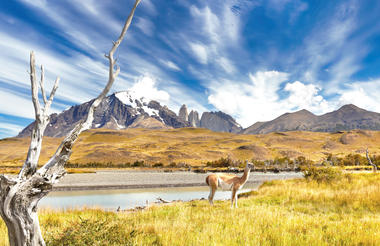
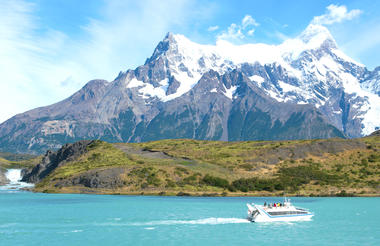
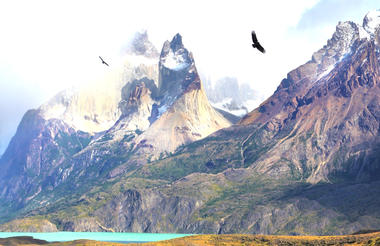
W Trek in Torres del Paine National Park, Patagonia.
To read before traveling
You are planning to do probably the best trek that can be done in Patagonia.
South America and specially Patagonia offers natural wonders and open spaces, a genuine mecca for hikers and wanderers. But no other place can offer such stunning beauty, a weather that tests your limits, long trails to enjoy the walks and the 3rd World´s largest ice field (with it´s glaciers), just there, altogether. On top of that, a Trek organized in a way that almost all can do it. People that once were pioneers in this remote place only visited by hard mountain climbers saw it coming and organized a system of “Refugios” (huts or shelters) and campgrounds to be able to dive deep into the wild without needing to go back to civilization, that is, to Puerto Natales.
Almost all can do this trek, but there are things to consider to have a great time and to avoid setbacks. Some parts of the trek are rated as difficult but if you take out the weather factor, we can say they are intermediate. Nevertheless, no matter how fit you are, if you are walking 10 hours with strong wind against you, you may wonder why you have decided to be there instead of a in warm place looking at the mountains with a cup of coffee in our hands. So there are bright and dark moments for everyone! Almost like life itself, got to endure the difficult times to savor the beautiful ones!
So the treks are breathtaking, the landscapes are out of this world, some passages are tough, but in the end of each day you will have a warm place to be in, to meet friends, to eat properly and to review all you have lived!
When to go? Torres del Paine is opened all year round. There are guided options in winter but most visitors go in spring, summer and early fall. The self guided treks are offered between the 15th September and the 30th April. Maybe you can´t manage your dates but try to avoid January and February because the park tends to be full of hikers that do the W, the O, and the ones that go for the day. Also, December, January and February is warmer but is windy season as well. If you can, choose October, November, March and April.
Can I go? As told before, almost anyone can do the trek, but we can tell you who can´t: People with a heart condition, people with serious knees injuries, pregnant women, people with high blood pressure (to be checked with your doctor). If you wonder if you are going to be fit enough, you probably are. But try to walk longer distances than usual, with your trekking boots on, 2 or 3 weeks before beginning the Trek. It is not a bad idea to spend some days in places like El Chalten to do some self guided treks before going to Torres del Paine to be in good shape.
How to get there? You can arrive by bus to Puerto Natales from Punta Arenas and from El Calafate (from May to Aug buses may not cross from El Calafate to Puerto Natales due to the weather conditions). From Puerto Natales there are regular buses to the gates of the park at 7.30 am and at 2.30 pm (always check, these times can change). There are also flights arriving to Puerto Natales and more regular flights are expected to arrive soon.
What to bring? This is a question that always arises. Always try to bring the minimum weight because you will hate yourself if you take things you are not going to use. But at the same time be sure you are taking what you really need (total estimate: around 10% of your weight?). Depending on how fashionable you are, try not to bring more than two items of each cloth (2 sweaters, 2 pants, 2 pairs of shoes, etc)
So here is a list:
-Backpack: try to use a backpack of between 40 and 50 liters. If you don´t have a rain cover use a garbage plastic bag in the inside to protect your clothes from the rain. There are parts of the w trek where you can leave the heavy items in the Refugio and walk lighter so maybe it is a good idea to have a smaller backpack to take with you the lunch box, you water bottle, and items like sun glasses, gloves, lip balm, camera, an extra pair of socks etc.
-Trekking boots: don´t save your money in this item and bring good waterproof boots, preferably already tested/used. Better if they are high to protect your ankles and wear them tight, not loose, to avoid blisters. If yours are not water proof bring a second pair of shoes in case one pair gets soaked.
-Warm jacket: feather jacket / primaloft / karpa but have always a light raincoat to wear on top of it when needed.
-Pants: bring them light, warm and easy to dry. You will be tempted in summer to use shorts, you can do it but always bring long pants in case it is very windy and the little stones and twigs make you suffer. If you have water proof pants bring them along.
-General trekking items: due to the instability of weather, bring: UV protection sunglasses, a buff, warm inner layers and underwear, hat, gloves, good socks, leg warmers
-Trekking poles or canes: it is quite hard to find natural canes or sticks that fit you to use during the w trek, and it is a good help to have trekking poles (4 legged animals are more stable!) so try to bring your own from home, otherwise you will be trying to rent or buy in Puerto Natales with an over price
-To be in the Refugios: comfy light shoes, sock, pants, t-shirt and sleep wear, toiletries. Towel is given but you can always take yours.
-Don´t forget: camera or phone to take pictures (you can charge them in the Refugios), head lamp, sunscreen, lip balm, mosquito repellent, a swiss knife, a padlock if you want to keeo your backpack safe in the lockers in some Refugios, your own medication (no medicine to be found in the park, so please take yours – painkillers, antihistamine, etc ). A bottle for water is provided in the w trek program. Bring band aids or similar to prevent blisters.
-Tent – Sleeping bag: Very important, in the W Trek programs you don´t need to carry your own tent or sleeping bag, they will be provided by the refugios/camp site. So a lot of weight less!
*Very important: you may be traveling for longer in south America and you probably got more luggage than needed for the trek. It is a good idea to leave all you need in a locker to go lighter to the park and return. Normally hostels keep your luggage for you fro 1 USD a day and youj can also leave luggage at the bus station for 2 to 3 USD a day depending on the quantity.
Where will I be sleeping? You have 3 options of accommodation: Shared bed at a Refugio (like a hostel), shared Tent with your friend, or a tent for your own.
Refugio: this place is more than a shelter, is a space where you are going to sleep, take a bath, have breakfast, dinner and make friends. Rooms are to share like a hostel. Common areas are very cozy. And each Refugio uses a different system of heating so temperature will depend on each place. Full licensed bar available.
Good thing about Refugio: you will be under a roof.
Bad thing about the Refugio: sometimes fellow travelers snore and it may be difficult to sleep.
Tent: Tents are already organized with their sleeping bag and mattress, so you don´t need to carry tent, sleeping bag or mattress with you. Campsites are perfectly located and have their own bathrooms and showers and people who use the camping also have breakfast and dinner in the Refugios and use them as common areas. You may wonder if you are going to be cold at night but all items are made of very good quality and you won´t be cold.
Good thing about Tent: you will have your privacy if you are alone or with a partner.
Bad thing about the Tent: when windy and rainy, the noise will probably disturb you.
What I am going to eat? During the W Trek programs, your food is included. That means:
Breakfast: a very complete breakfast in the Refugio, no matter where you sleep.
Lunch box (a bag, to be honest): It contains a powerful sandwich or wrap, a small bag of dry fruits/nuts, a fruit (orange/apple/etc), a cereal bar and a chocolate.
Dinner: a very complete and even gourmet dinner. Entrée, main dish, bread and desert.
So for most people it is more than enough. If you like sweet stuff or you know you eat above average, you can take something extra with you, or you can buy at the Refugios. One of the wonderful things of the W Trek is not needing to carry your own food with you!
How much / How long will I be walking? Be prepared to endure long (but beautiful) walks. If you compare your Health app with the CONAF distances you will find out that you walk more than expected. Distances are about the following:
Day 2 from Sector Central to Base Torres and return, if you sleep 2 nights at central: 28 km or about 9 hours (If you sleep in Chileno it is 7 hours but the extra 2 hours will need to be done the following day)
Day 3 from Sector Central to Refugio Frances: 24 km or about 7-8 hours (if you are going from Chileno add one hour and a half or 2)
Day 4 from Refugio Frances to Paine Grande via mirador Frances and mirador Britanico: 20 km or about 8 to 9 hours.
Day 5 from Paine Grande to… ?. This Is the last day and you need to take the Catamaran to cross the lake so you are going to do a round trip as far as you can make it considering being ready to take the boat. Most people do the Grey lookout, to see the glacier. Some other walk further. You may walk 12-14 km or about 5-6 hours but it will depend on your decision.
Ref walking times: it will depend on the weather conditions (wind or rain), on your fitness and on your company. If you are in a small group or with friends, the slowest will set the pace.
What happens in case I can´t complete one sector? Some people wonder how to proceed if something happens. In the unlikely case that you get injured (knee or ankle, for example), you have to begin moving as much as you can in the direction of the closest Refugio. So if you have an accident 2 hours from the last Refugio, just go back, and tell people you find in the trails that you are not ok. They will pass the news to Conaf rangers or to W Trek guides. Also there are guides here and there so let them know what happened and they will help you. Again remember that there are no medicines to be found in the park so you have to take your own stock. From the Refugios there is always a way to carry people that can´t move, in van, car or boat. So the closest Refugio is your goal if you don´t feel well.
Some tips to enjoy your trek.
-Try to sleep well and depart early to be able to arrive before dark (in summer it gets dark very late, though) and to be able to be in the trails before everyone.
-It is best to avoid alcohol (it will be hard not to be tempted by a pisco sour or a chilean beer!)
-Manage your energy, this is not a sprint but a long distance race. And enjoy while walking finding your own pace, you won´t forget the landscape you will discover.
-Try to stretch when you arrive to each destination and you will notice that your fitness will increase with the days
-If you are alone try to meet other trekkers to be with other people. It is safer and more fun.
-Your enemies are: rain, wind and blisters. Not much to do against weather but take care of your feet, you will do maybe 20.000 steps per day or more. So comfortable and tight trekking boots/shoes, good socks (a pair extra dry socks always in your backpack). Bandaids or similar in case some areas begin to sore – touch your feet to prevent.
-Water is perfectly drinkable, you can just fill the bottle provided for the W trek in the several rivers. Keep hydrated.
-If you are planning to do Kayak or the Glacier Trek in Grey Glacier, you will need to add a 5th night to the W and sleep one night at Refugio Grey.
-If you think you are going to miss your family and friends, the Refugios have wifi, so you can be connected if you want. It has a cost (from 5 USD the hour, different plans). On a second thought, maybe it is great to enjoy an offline holiday and connect with your surroundings and fellow trekkers!
-Please take care with the white PDI paper you are getting in the Chilean border. Don’t lose it, it will be asked for when going out of Chile
-Some people like to arrive to Puerto Natales from El Calafate at 1 pm and from there just go to Torres del Paine to begin the trek. But in high season there are many people crossing the border and bus timetable will depend on that. If you arrive later than 2.30 pm you will miss the bus and your 1st W Trek day. It is better to arrive a day before and spend 1 night in Puerto Natales before doing the W Trek
Hoping that these words will help you when planning the W Trek, we honestly expect that you have an unforgettable experience in one of the most beautiful corners of our dear planet.
HI Travel Team
Sector Central - Sector Frances (or Cuernos)
Walk along the tranquil shore of Lake Nordenskjöld and at the base of the amazing Almirante Nieto Mount and its hanging glaciers. The hushed atmosphere of the massive peaks above the turquoise lake will beg you to slow down, process the magnitude and capture that view forever with a photograph. The lake is surrounded by geographic contrasts and is home to many birds, so keep an eye out for condors flying in this area. You will continue along the Arriero river, which offers great opportunities to take a nice long break to fill your water bottle and enjoy the
present moment. Once at the highest viewpoint, you will be able to see the lake in its entirety and the Francés Glacier on Paine Grande mount.
NIGHT 2 of W-Trek: Refugio Frances (or Cuernos)
Hike: 4,5-6,5 hours. 13,5 km (8,4 mi.)
Difficulty: Medium
Elevation gain: 80 m
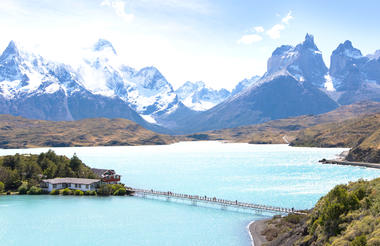
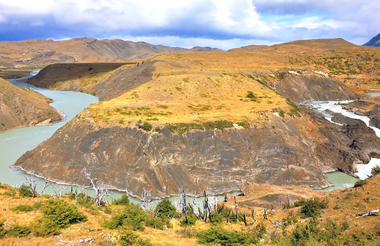
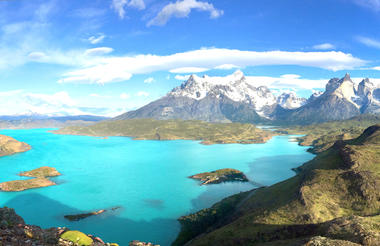
Trekking the Frances Valley
Recommended time to begin the trek: 9am
Start your morning in the perfect way with a light and magnificent trek to Italiano camping. Your mind and body will be aligned with the present moment, processing all the experiences of the previous days. Surrounded by mountains, you will find peace of mind, the sounds and smells of the lake will make you vibrate with energy in the midst of a varied and abundant vegetation that will fill you with life.
You will pass by an amazing waterfall and you will be able to fill your bottle with pure and cold water. This whole experience will be perfectly complemented by the incomparable view from the Francés Valley. At the viewpoint, you will be dazzled with one of the most
impressive views of the entire circuit. You can continue to Britanico lookout and then hike your way down to Frances to spend the 3rd night to the W Trek
NIGHT 3 of W-Trek: Refugio Frances
Hike: 7-8 hours. 15 km (9,3 mi.)
Difficulty: High
Elevation gain: 712 m



Trekking to Grey Lookout: Sector Frances - Paine Grande - Grey Lookout - Paine Grande - Pehoe Lake - Pudeto - Puerto Natales
Recommended time to begin the trek: 8am
First you have to hike to Paine Grande and then do a roundtrip trek to the Grey Glacier Lookout. After about one and a half hours from Paine Grande the traveler will reach the first lookout, where it’s possible to observe the glacier at a distance. From there, the traveler will follow a path that circles the west bank of Lake Grey. After about one and a half / two hours the traveler will reach the main lookout with spectacular views of Grey Glacier, Cordón Olguín and the ice floes. The return journey follows the same path, arriving to the sector known as Pehoé. At the pier you will board a ferry and take a trip across Lake Pehoé, disembarking at the sector known as Pudeto from which point a transfer will be waiting to take customers back to Puerto Natales. You have to make your way from the bus station to your accommodation in Puerto Natales
Ferry Itinerary PM / AM:
-Registration time at the pier: 6.00pm/ Departure: 6.30pm/ Approximate arrival time to Rodoviario Natales: 10pm. Go on your own to your accommodation
-It’s important that on this day you effectively calculate walking times in order to be on time for the ferry departures.
-When walking to the glacier lookout, backpacks can be safely left at Paine Grande Lodge (a fee aplies) if you need to get rid of them for a while
Hike: 7-8 hours. 22 km (13,6 mi.)
Difficulty: High
Elevation gain: 280 m



Puerto Natales – Punta Arenas Airport
Breakfast and check out. You make our own way to the bus station to take the Punta Arenas Airport public bus (or Punta Arenas city if you are not flying out). Bus Times: 07.00 hs / 10.00 hs / 12.30 hs / 15.00 hs / 17.15 hs / 19.00 hs / 21.00 hs. Optional: Return bus to El Calafate. If your flights departs from Puerto Natales airport, transfer is also included





